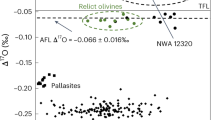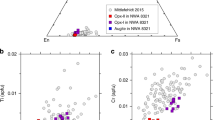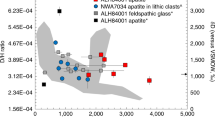Abstract
The shergottites, nakhlites and Chassigny, collectively known as the SNC meteorites, seem to define a petrological and geochemical sequence1. Together with their young radiometric solidification ages of only ∼1,300 Myr (refs 2–9), this has been interpreted as evidence for magmatic activity on their parent body late in its history. Such late magmatism is most easily envisaged for planetary-sized bodies and it has been suggested that SNC meteorites are derived from Mars (see resf. 10 and refs therein). This suggestion is supported by the apparent similarities between the noble gas and nitrogen composition of the present martian atmosphere11,12 and gases trapped in shock-produced glass phases of the shergottite EETA 79001 (refs 13, 14). Our analyses of trapped argon, krypton and xenon in Shergotty, Nakhla and Chassigny reported here show, however, that these meteorites do not contain unadulterated noble gases from the martian atmosphere, fractionated or not. They indicate that for Nakhla and Chassigny, in particular, a martian origin is only possible if the martian atmosphere contains a higher fraction of radiogenic 129Xe and of fissiogenic xenon than does xenon in martian rocks. This is the opposite of the situation on Earth.
This is a preview of subscription content, access via your institution
Access options
Subscribe to this journal
Receive 51 print issues and online access
$199.00 per year
only $3.90 per issue
Buy this article
- Purchase on Springer Link
- Instant access to full article PDF
Prices may be subject to local taxes which are calculated during checkout
Similar content being viewed by others
References
Stolper, E., McSween, H. Y. Jr & Hays, J. F. Geochim. cosmochim. Acta 43, 589–602 (1979).
Podosek, F. A. Earth planet. Sci. Lett. 19, 135–144 (1973).
Papanastassiou, D. A. & Wasserburg, G. J. Geophys. Res. Lett. 1, 23–26 (1974).
Gale, N. H., Arden, J. W. & Hutchison, R. Earth planet. Sci. Lett. 26, 195–206 (1975).
Nakamura, N., Unruh, D. M., Tatsumoto, M. & Hutchison, R. Meteoritics 12, 324–325 (1977).
Bogard, D. D. & Husain, L. Geophys. Res. Lett. 4, 69–71 (1977).
Wooden, J. L. et al. Lunar planet. Sci. 10, 1379–1381 (1979).
Bogard, D. D. & Nyquist, L. E. Meteoritics 14, 356 (1979).
Shih, C.-Y. et al. Geochim. cosmochim. Acta 46, 2323–2344 (1982).
Wood, C. A. & Ashwal, L. D. Proc. lunar planet. Sci. Conf. 12 B, 1359–1375 (1981).
Owen, T. et al. J. geophys. Res. 82, 4635–4639 (1977).
Pollack, J. B. & Black, D. C. Icarus 51, 169–198 (1982).
Bogard, D. D. & Johnson, P. Science 221, 651–654 (1983).
Becker, R. H. & Pepin, R. O. Earth planet. Sci. Lett. 69, 225–242 (1984).
Ganapathy, R. & Anders, E. Geochim. cosmochim. Acta 33, 775–787 (1969).
Prior, G. Mineralog. Mag. 16, 274–291 (1912).
Ozima, M. & Podosek, F.A. Noble Gas Geochemistry (Cambridge University Press, 1983).
Podosek, F. A. Geochim. cosmochim. Acta 34, 341–365 (1970).
Jordan, J., Kirsten, T. & Richter, H. Z. Naturforsch. 35 a, 145–170 (1980).
Anders, E. & Owen, T. Science 198, 453–465 (1977).
Matsuda, J.-I., Lewis, R. S., Takahashi, H. & Anders, E. Geochim. cosmochim. Acta 44, 1861–1874 (1980).
Mazor, E., Heymann, D. & Anders, E. Geochim. cosmochim. Acta 34, 781–824 (1970).
Podosek, F. A., Honda, M. & Ozima, M. Geochim. cosmochim. Acta 44, 1875–1884 (1980).
Wacker, J. F. & Anders, E. Geochim. cosmochim. Acta 48, 2373–2380 (1984).
Author information
Authors and Affiliations
Rights and permissions
About this article
Cite this article
Ott, U., Begemann, F. Are all the ‘martian’ meteorites from Mars?. Nature 317, 509–512 (1985). https://doi.org/10.1038/317509a0
Received:
Accepted:
Published:
Issue Date:
DOI: https://doi.org/10.1038/317509a0
This article is cited by
-
Core Formation and Mantle Differentiation on Mars
Space Science Reviews (2013)
-
On the chronology of lunar origin and evolution
The Astronomy and Astrophysics Review (2013)
-
Noble gases in atmospheres
Nature (1993)
-
Possible cometary origin of heavy noble gases in the atmospheres of Venus, Earth and Mars
Nature (1992)
Comments
By submitting a comment you agree to abide by our Terms and Community Guidelines. If you find something abusive or that does not comply with our terms or guidelines please flag it as inappropriate.



